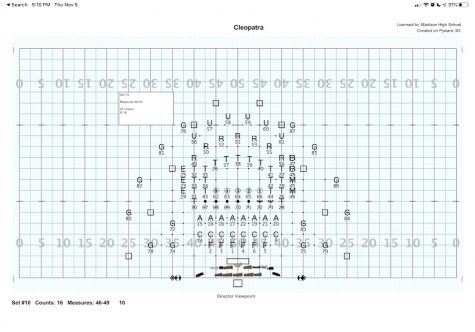Marching Band

Madisons 2020 marching show "Cleopatra."


Every year, Madison’s marching band works hard to learn a new show. Marching band takes up both zero hour and first hour but the band begins learning before school starts.
First, the staff chooses music for the show. This music is written specifically for marching bands to use. This year, the music came from a composer in California. Then, the staff writes where each student will move with the music.
“The drill is written by myself and my staff over the summer. We listen to the music and […] then we have to go in and plot every individual person from set to set on where they’re going to be and how they are going to get there,” Mr. Klingler, the director of Madison’s marching band said.
After the drill is written, students get a book containing pictures of every set with little dots that represent each person. The students can then highlight where they are on the page and go to that spot on the field. In order to memorize these movements, the band has two summer camps.
“We have a band camp early in the summer that is music camp and we just […] get a head start on the music which then they practice throughout the summer. Towards the end of the summer we have a camp where we normally go away somewhere […] for a week and we actually continue to memorize the music and set and learn all of the drill on the field,” Klingler said.
Once the band has learned some of the music and drill at camp, they can practice and perfect the show during the school year.
“During zero hour and first hour, during normal season, we are just practicing the music, getting it clean, getting it memorized and then synchronizing it with the marching drill itself out on the stadium,” Klingler said.
The most challenging part of band for most students is to cleanly move and set shapes with other people while playing music. To help with this, students color code their music to match the drill.
“We put one color for when you’re moving and an arrow to show where you’re going for the next set and another color to represent when you’re holding or another color to represent when you’re doing a visual,” said sophomore Clara Rose.
There are about 104 students participating in the band so drum majors help to direct them. On average, about 40 students audition for the position of drum major but in the end, only four will be chosen.
“Drum major is a whole audition. We just started the process and they have a whole bunch of auditions they have to go through from marching, to calling commands to other students, conducting, they have to do a leadership situations test where they have to fill out what you would do in certain situations or scenarios. Then the band gets to do a confidence vote which I then take into consideration on who’s going to be the drum majors,” Klingler said.
The students grow closer together as they all work together through the years.
“The best part of the band in general is the family that they build. They are a family with each other, they care about each other, they support each other and it’s just kind of like a second family for them where everybody fits in and everybody is a part of what they love to do,” Klingler said.





